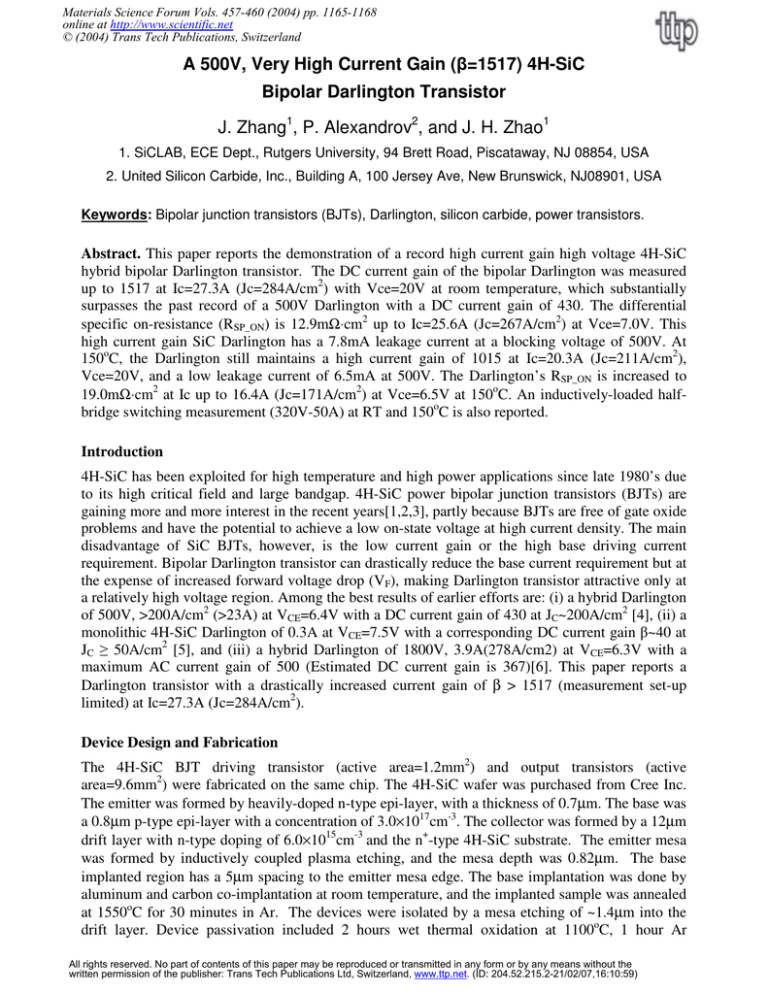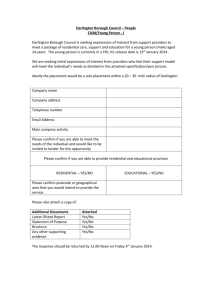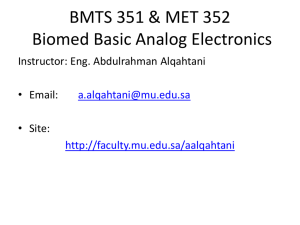
Materials Science Forum Vols. 457-460 (2004) pp. 1165-1168
online at http://www.scientific.net
© (2004) Trans Tech Publications, Switzerland
A 500V, Very High Current Gain (β=1517) 4H-SiC
Bipolar Darlington Transistor
J. Zhang1, P. Alexandrov2, and J. H. Zhao1
1. SiCLAB, ECE Dept., Rutgers University, 94 Brett Road, Piscataway, NJ 08854, USA
2. United Silicon Carbide, Inc., Building A, 100 Jersey Ave, New Brunswick, NJ08901, USA
Keywords: Bipolar junction transistors (BJTs), Darlington, silicon carbide, power transistors.
Abstract. This paper reports the demonstration of a record high current gain high voltage 4H-SiC
hybrid bipolar Darlington transistor. The DC current gain of the bipolar Darlington was measured
up to 1517 at Ic=27.3A (Jc=284A/cm2) with Vce=20V at room temperature, which substantially
surpasses the past record of a 500V Darlington with a DC current gain of 430. The differential
specific on-resistance (RSP_ON) is 12.9mΩ⋅cm2 up to Ic=25.6A (Jc=267A/cm2) at Vce=7.0V. This
high current gain SiC Darlington has a 7.8mA leakage current at a blocking voltage of 500V. At
150oC, the Darlington still maintains a high current gain of 1015 at Ic=20.3A (Jc=211A/cm2),
Vce=20V, and a low leakage current of 6.5mA at 500V. The Darlington’s RSP_ON is increased to
19.0mΩ⋅cm2 at Ic up to 16.4A (Jc=171A/cm2) at Vce=6.5V at 150oC. An inductively-loaded halfbridge switching measurement (320V-50A) at RT and 150oC is also reported.
Introduction
4H-SiC has been exploited for high temperature and high power applications since late 1980’s due
to its high critical field and large bandgap. 4H-SiC power bipolar junction transistors (BJTs) are
gaining more and more interest in the recent years[1,2,3], partly because BJTs are free of gate oxide
problems and have the potential to achieve a low on-state voltage at high current density. The main
disadvantage of SiC BJTs, however, is the low current gain or the high base driving current
requirement. Bipolar Darlington transistor can drastically reduce the base current requirement but at
the expense of increased forward voltage drop (VF), making Darlington transistor attractive only at
a relatively high voltage region. Among the best results of earlier efforts are: (i) a hybrid Darlington
of 500V, >200A/cm2 (>23A) at VCE=6.4V with a DC current gain of 430 at JC~200A/cm2 [4], (ii) a
monolithic 4H-SiC Darlington of 0.3A at VCE=7.5V with a corresponding DC current gain β~40 at
JC ≥ 50A/cm2 [5], and (iii) a hybrid Darlington of 1800V, 3.9A(278A/cm2) at VCE=6.3V with a
maximum AC current gain of 500 (Estimated DC current gain is 367)[6]. This paper reports a
Darlington transistor with a drastically increased current gain of β > 1517 (measurement set-up
limited) at Ic=27.3A (Jc=284A/cm2).
Device Design and Fabrication
The 4H-SiC BJT driving transistor (active area=1.2mm2) and output transistors (active
area=9.6mm2) were fabricated on the same chip. The 4H-SiC wafer was purchased from Cree Inc.
The emitter was formed by heavily-doped n-type epi-layer, with a thickness of 0.7µm. The base was
a 0.8µm p-type epi-layer with a concentration of 3.0×1017cm-3. The collector was formed by a 12µm
drift layer with n-type doping of 6.0×1015cm-3 and the n+-type 4H-SiC substrate. The emitter mesa
was formed by inductively coupled plasma etching, and the mesa depth was 0.82µm. The base
implanted region has a 5µm spacing to the emitter mesa edge. The base implantation was done by
aluminum and carbon co-implantation at room temperature, and the implanted sample was annealed
at 1550oC for 30 minutes in Ar. The devices were isolated by a mesa etching of ~1.4µm into the
drift layer. Device passivation included 2 hours wet thermal oxidation at 1100oC, 1 hour Ar
All rights reserved. No part of contents of this paper may be reproduced or transmitted in any form or by any means without the
written permission of the publisher: Trans Tech Publications Ltd, Switzerland, www.ttp.net. (ID: 204.52.215.2-21/02/07,16:10:59)
1166
Silicon Carbide and Related Materials 2003
annealing at 1100oC, 3 hours low-temperature wet-oxygen re-anneal at 950oC, as well as PECVD
deposited 250nm SiO2 and 250nm Si3N4. Al-free Ohmic contacts (200nm Ti covered by 200nm
TiN) were sputtered on both emitter and base. AlTi(20nm)/Ni(700nm) bi-layer was used as the
collector contact metal. All the contacts were annealed in hydrogen and nitrogen forming gas for 8
minutes at 1050oC. After the Ohmic contact formation, a thick layer of PECVD SiO2 (410nm) and
Si3N4 (250nm) was deposited for insulation between the overlay metals. The final overlay metals
were Ti(50nm) and Au(1.5µm) on the emitter and base, Ni(100nm) and Au(700nm) on the
collector.
After characterization on each BJT cells on the
chip, the sample was then die mounted into a multipin metal package and ribbon-bonded. One BJT cell
was used as the driving transistor(T1), and 8 other
cells were used to form the output transistor(T2).
The hybrid 4H-SiC bipolar Darlington transistor
containing a monolithic multi-cell BJT chip was
completed by connecting the emitter pin of the
driving transistor(T1) to the base pin of the output
transistor(T2) which contains 8 BJT cells in parallel.
Fig.1 shows the formation of the hybrid Darlington
transistor.
Fig.1. Formation of a Darlington transistor.
Characterization and Discussion
The high performance driver BJT I-V curves are shown in Fig.2. The peak current gain was 47 at
IC1=4.7A (JC1=392A/cm2) and VCE1=10V at room temperature. The specific on-resistance (RSP_ON)
was 9.4mΩ⋅cm2 at IC1=6.36A (JC1=530A/cm2) and VCE1=5.0V. Fig.3 shows the I-V characteristics
of the output transistor. The peak DC current gain was 44 at IC2=35A (JC2=366A/cm2) and
VCE2=10V. The RSP_ON was 10.5mΩ⋅cm2 for current up to IC2=55.1A(JC2=574A/cm2) and
VCE2=6.0V.
Fig.2. I-V characteristics of the driver BJT(T1).
Fig.3. I-V characteristics of the output BJT(T2).
The hybrid BJT Darlington transistor’s RT and 150oC I-V characteristics are shown in Fig.4. A
record high DC current gain of 1517 was obtained at room temperature at IC=27.3A (JC2~284A/cm2)
at VCE2=20V, which is the highest high voltage SiC BJT Darlington current gain reported to date.
The gain could be even higher at higher collector current level, as evidenced by the current gain
curves shown in Fig.5(a) and (b), but the measurement was at present limited by the instrument.
Fig.4(a) shows the Darlington has a differential RSP_ON of 12.9mΩ⋅cm2 for current up to Ic=25.6A
Materials Science Forum Vols. 457-460
1167
(JC2~267A/cm2) at VCE2=7.0V. The current gain decreased at elevated temperatures, but still
maintained a high gain of 1015 at Ic=20.3A (JC2~211A/cm2) at 150oC. The differential RSP_ON
increased to 19.0mΩ⋅cm2 up to IC=16.4A (JC2~171A/cm2) at VCE2=6.5V at 150oC. The open base
blocking performance was measured up to VCEO=500V at room temperature with a leakage current
of 7.8mA. At 150oC, the leakage current was 6.5mA at VCEO=500V. Fig.5 shows the DC current
gain versus the collector current level at Vce=10V for the driver BJT, the output transistor and the
BJT Darlington transistors, respectively.
(b) At 150oC.
(a) At room temperature.
Fig.4. I-V characteristics of the 4H-SiC Darlington BJT.
Collector Current (A)
2.0
4.0
6.0
8.0
10.0 500
o
45
T=25 C
40
35
o
T=150 C
30
25
0
at Vce=10V
10
Collector Current (A)
20 30 40 50 60
70
o
T=25 C
45
35
o
T=150 C
25
20
167
333
500
667
833
0 104 208 313 417 521 625 729
2
2
Collector Current Density (A/cm )
Collector Current Density (A/cm )
(a) Driver BJT(T1).
0
1600
1400
1200
1000
800
40
30
Common Emitter Current Gain
500.0
Common Emitter Current Gain
Common Emitter Current Gain
The switching properties of this high power hybrid Darlington transistor has also been tested in
an inductively-loaded half-bridge inverter with a SiC MPS (Merged-PiN-Schottky) serving as the
freewheeling diode. A 1mH inductor load was used to simulate an induction electric motor. Fig.6
shows switching waveforms at room temperature and at 150oC, with a bus voltage of 320V and a
switching current of 50A. Results showed that the collector current (Ic) had a turn-on rise time of
0.16µs at both room temperature and 150oC, and a turn-off fall time of 0.15µs at room temperature
and 0.13µs at 150oC. At room temperature, the turn-on switching energy loss was 5.68mJ, while
the turn-off energy loss was 3.15mJ. Two different working modes of the Darlington transistor can
be clearly distinguished from Fig.6. At room temperature, the Darlington worked in saturation
mode with both base-emitter and base-collector junctions forward-biased which explains the high
Collector Current (A)
5 10 15 20 25
30
o
T=25 C
o
T=150 C
600
400
200
0
(b) Output BJT(T2).
Fig.5. Current gain at different collector current levels.
0 52 104 156 208 260 313
2
Collector Current Density (A/cm )
(c) Darlington transistor.
Silicon Carbide and Related Materials 2003
Summary
Ic (A)
60
RT
40
20
o
150 C
0
12.0
14.0
16.0
18.0
16.0
18.0
0.4
Vce (kV)
base current. While at 150oC, due to
the reduced current gain, the same
base bias voltage kept the Darlington
working in active region where basecollector junction was still reverse
biased. In this desired mode of
operation, the base current required
to switch 50A was less than 0.05A.
Compared to the single stage 4H-SiC
BJTs, the base driving current is
much less for the Darlington BJT,
which substantially lowers the base
driving requirement. However, as
shown by the long VCE falling time,
better base drive circuit design is
needed and device parasitic RC time
should be reduced in order to achieve
a better switching performance.
o
150 C
0.2
0.0
12.0
0.6
0.4
0.2
0.0
-0.2
RT
14.0
RT
Ib (A)
1168
12.0
o
150 C
14.0
16.0
18.0
Time (µs)
Fig.6 Half-bridge inverter switching waveforms for
4H-SiC Darlington BJT using SiC MPS freewheeling
diode. The load was a 1mH inductor.
A record high current gain (β=1517)
was demonstrated for a high
power(500V-27A) SiC hybrid bipolar Darlington transistor. At room temperature, the DC current
gain was measured up to 1517 at JC2~284A/cm2. And a very high current gain of 1015 was still
maintained at JC2~211A/cm2 at 150oC. The Darlington blocked 500V both at room temperature and
at 150oC, and the differential RSP_ON was 12.9mΩ.cm2 and 19.0mΩ⋅cm2 at room temperature and
150oC, respectively.
Inductively-loaded half-bridge inverter switching at 320V-50A was
demonstrated with the Darlington in active mode showing a base driving current < 0.05A.
Acknowledgment
Authors at Rutgers University acknowledge financial support provided by United Silicon Carbide
(USC), Inc.. Authors at USC Inc. acknowledge financial support provided by Army TACOM SBIR
program (Contract No. DAAE07-02-C-L050) managed by Dr. T. Burke.
References
[1] Y. Luo, L. Fursin, J.H. Zhao: IEE Elec. Letters. Vol.36, (2000), p.1496.
[2] C-F Huang, J. A. Cooper, Jr.: IEEE Dev. Res. Conf. Digest, (2002), p183.
[3] S.Ryu, A.K. Agarwal, R.Singh, J.W. Palmour: IEEE Elec. Dev. Lett., Vol.22,(2001), p124.
[4] Y. Luo, J. Zhang, P. Alexandrov, L. Fursin, J. H. Zhao: IEEE 61st Dev. Res. Conf. Digest
(2003), p25.
[5] Y.Tang, and T.P.Chow: ISPSD-2003, p.383
[6] S. Ryu, A.K. Agarwal, R.Singh, J.W. Palmour: IEEE 58th Dev. Res. Conf. Digest (2000), p.133.



